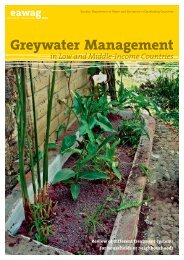Household Water Treatment and Safe Storage Factsheet: Source ...
Household Water Treatment and Safe Storage Factsheet: Source ...
Household Water Treatment and Safe Storage Factsheet: Source ...
You also want an ePaper? Increase the reach of your titles
YUMPU automatically turns print PDFs into web optimized ePapers that Google loves.
<strong>Household</strong> <strong>Water</strong> <strong>Treatment</strong> <strong>and</strong> <strong>Safe</strong> <strong>Storage</strong><br />
Fact Sheet: Chlorine (NaDCC Tablets) Key Data<br />
Labour:<br />
Anyone can be trained for light packaging work<br />
Hazards:<br />
NaDCC tablets are safe to h<strong>and</strong>le <strong>and</strong> store<br />
Maintenance<br />
<br />
<br />
Products should be protected from exposure to temperature extremes or high humidity<br />
Should be stored away from children<br />
Direct Cost<br />
Capital Cost(s) Operating Cost(s) Replacement Cost<br />
US$0<br />
US$0.03/20 litre tablet 1<br />
US$10.95/year 2<br />
US$0<br />
Note: Program, transportation <strong>and</strong> education costs are not included. Costs will vary depending on location.<br />
1 Medentech (2009)<br />
2<br />
Assumed 20 litres/household/day<br />
Other<br />
<br />
<br />
<br />
Some users complain about the taste <strong>and</strong> odour that chlorine may cause in water, some<br />
NaDCC products claim that at there is no bad odour or taste using the recommended doses<br />
Chlorine reacts with organic matter naturally present in water to form by-products such as<br />
trihalomethanes (THMs), which are potentially cancer-causing<br />
Study results indicate THM levels produced during household chlorination may fall below<br />
WHO guideline values (Lantagne et al., 2008)<br />
References<br />
Clasen, T. <strong>and</strong> P. Edmondson (2006). Sodium dichloroisocyanurate (NaDCC) tablets as an<br />
alternative to sodium hypochlorite for the routine treatment of drinking water at the household level.<br />
International Journal of Hygiene <strong>and</strong> Environmental Health Volume 209, Issue 2, pp. 173-181.<br />
Clasen, T., Saed, T., Boisson, S., Edmondson, P., <strong>and</strong> O. Shipin. (2007). <strong>Household</strong> <strong>Water</strong><br />
<strong>Treatment</strong> Using Sodium Dichloroisocyanurate (NaDCC) Tablets: A R<strong>and</strong>omized, Controlled Trial<br />
to Assess Microbiological Effectiveness in Bangladesh. Am. J. Trop. Med. Hyg., 76(1), 2007, pp.<br />
187–192.<br />
Lantagne, D.S., Blount, B. C., Cardinali, F., <strong>and</strong> R. Quick, R (2008). Disinfection by-product<br />
formation <strong>and</strong> mitigation strategies in point-of-use chlorination of turbid <strong>and</strong> non-turbid waters in<br />
western Kenya. Journal of <strong>Water</strong> <strong>and</strong> Health, 06.1, 2008.<br />
Lantagne, D. (2009). Summary of Information on Chlorination <strong>and</strong> pH. Prepared for UNICEF.<br />
Medentech (2009). Personal communication, March 2009.<br />
Molla, N., (2007). Practical <strong>Household</strong> Use of the Aquatabs Disinfectant for Drinking <strong>Water</strong><br />
<strong>Treatment</strong> in the Low-Income Urban Communities of Dhaka, Bangladesh. Thesis, Asia Institute of<br />
Technology, School of Environment, Resources <strong>and</strong> Development.<br />
Further Information<br />
Medentech Ltd: www.aquatabs.com or www.medentech.com<br />
CAWST (Centre for Affordable <strong>Water</strong> <strong>and</strong> Sanitation Technology)<br />
Calgary, Alberta, Canada<br />
Website: www.cawst.org, Email: cawst@cawst.org<br />
Last Update: June 2011
















